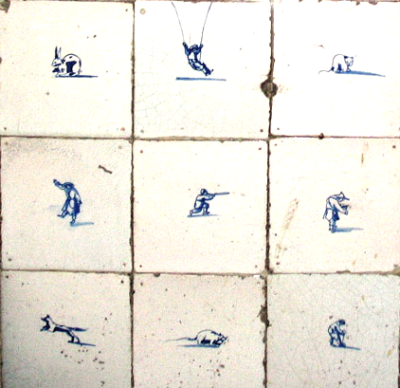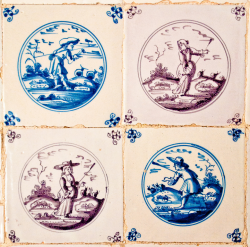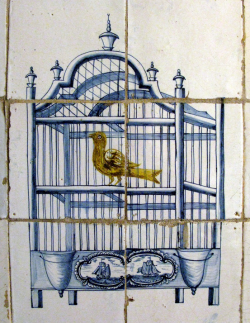
The history of Delft tiles goes back to the early 1600s when blue and white porcelain from China first arrived in the Netherlands. It was much admired and Dutch potters wanted to imitate the look, even though they couldn’t recreate true Chinese porcelain.
Potteries in Delft had some success with good quality blue and white glazed earthenware. Craftsmen in the city who were already making multi-coloured tiles soon started to work with the new colour scheme.
The tile-makers began by rolling out a clay mixture and cutting squares from it by pressing a wooden frame into the clay. Typically these were 1 cm deep with 13 cm edges. They were dried before firing in a kiln heated to around 1000°C. Next liquid white tin glaze was spread on the upper surface and left to dry naturally.
Decorating the surface

Decorative scenes were sketched on paper. Pricking through the outlines with a pin created a stencil, or pricked transfer, called a spons. Then a bag of charcoal dust was rubbed through the pinholes onto the glaze. Painters followed the charcoal tracing and sometimes added freehand shading to the design. The characteristic cobalt blue decoration fused into the opaque white surface during a second firing. Manganese-based purple, introduced in the later 17th century, was sometimes chosen as an alternative to blue.
Dutch homes used tiles generously round chimneypieces and stoves, in kitchens, and decorating hallways or stairs. Scenes from everyday life were popular: children playing, animals, workers, soldiers, or ships and harbours.
“Delft” tiles were made in other parts of the Netherlands too, for export as well as for local buyers. Social and economic trends meant that ceramic production was centred on Delft by about 1700, but was greatly reduced in that city by 1800.*

Antique hand-made tiles don’t look as smooth as reproductions made in modern factories. The glaze is more crackled, with colour variations in the white, and there may be indentations where the tiles were held in place by nails in the early stages before firing.
The Delft style and technique was used for a range of household and ornamental ceramics – often called Delftware or Delft Blue – not just for tiles. By the later 19th century Dutch tile manufacturers were losing out to industrial competitors elsewhere in Europe, but the Delft tile name lives on and is still popular today, whether new or antique.
More tile history from the Netherlands Tile Museum.
Photos
Photographers credited in captions. Links to originals here:
Early Delft tiles, Manganese tiles in England, Birdcage tile panel, More picture info here
Notes
*According to de Vries and van der Woude in The First Modern Economy: Success, Failure, and Perseverance of the Dutch Economy, 1500-1815
I blog frequently and I truly thank you for your content.
This article has really peaked my interest. I will bookmark your
site and keep checking for new details about once a week.
I opted in for your Feed as well.
LikeLike
I don’t even know how I ended up here, but I thought this post was good.
I do not know who you are but definitely you’re going to a famous blogger if you aren’t already 😉 Cheers!
LikeLike
I drop a comment whenever I appreciate a article on a website or
if I have something to valuable to contribute to the conversation. Usually it is a result of the passion displayed in the article
I read. And on this post Delft blue tiles – not always blue, not
always from Delft — Home Things Past. I was excited enough
to drop a thought 😛 I actually do have 2 questions for you if it’s allright.
Is it only me or do some of the remarks appear as if they are written by brain dead people?
😛 And, if you are writing at additional places,
I’d like to keep up with you. Would you make a list every one of your social pages like your Facebook page, twitter feed, or linkedin profile?
LikeLike
This article provides clear idea in support of the new visitors of blogging, that actually how to do blogging
and site-building.
LikeLike
Hi, I desire to subscribe for this website to take
most up-to-date updates, therefore where can i do it please help out.
LikeLike
It’s amazing in favor of me to have a site, which is beneficial designed for my experience.
thanks admin
LikeLike
I know this web page presents quality dependent articles
or reviews and extra data, is there any other site which gives these things in quality?
LikeLike
After going over a few of the blog posts on your web page, I
honestly like your technique of writing a blog. I saved it to my bookmark webpage list and will be checking back in the near future.
Please check out my web site too and tell me how you feel.
LikeLike
Great article on the history of Dutch tiles. Although they are mainly known as ‘Delft’ tiles, the factories were spread all across the country. Good to point that out 😉
LikeLike